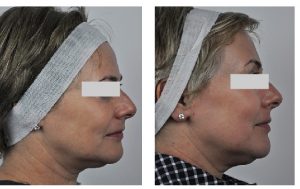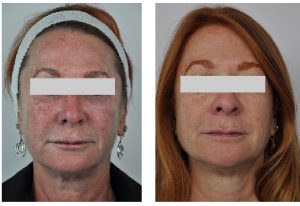CONTACT US

Treatment of aging skin using the SharpLight OmniMax multiple modality platform
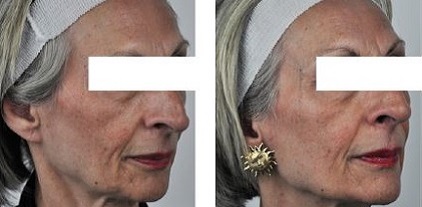
Dr. Lisa Kellett, M.D., F.R.C.P.(C), D.A.B.D. Dermatologist, DLK on Avenue
Abstract
Background: Historically, lasers were originally developed as one wavelength platforms targeting a single chromophore and excelling in the treatment of a particular cutaneous skin concern. Specifically, various types of pigment and vascular lesions. With advances in technology such as the SharpLight OmniMax, a single platform can now treat multiple chromophores with different lasers and light source wavelengths incorporated into the design.
Objective: To evaluate the SharpLight OmniMax device and its effectiveness in treating photoaged skin and the multiple skin concerns associated with it.
Methods: The SharpLight OmniMax device was used to treat 10 patients with photoaged skin. Patients were chosen on the basis of being good clinical photo aging candidates. Specifically, all had lentigines, both static and dynamic rhytides, skin laxity, dyschromia, and telangiectasia. Each patient received 4 treatment sessions spaced 2-3 weeks apart. During each session, 3 types of treatments using different modalities were used. All 3 modalities were on the same platform. Each session consisted of treatment with intense pulsed light with cut off filters 580nm and/or 535 nm, followed by an infrared treatment and then an Erbium YAG 2940 nm resurfacing treatment.
Results: Patients reported an improvement in texture, tone, colour and wrinkles. 100% expressed an improvement in the overall look of their skin. Review of before and after photographs also demonstrated an improvement in lentigines, dyschromia, telangiectasia and fine lines.
Conclusion: The use of the SharpLight OmniMax device is an effective method of treating the many signs of photo aged skin including lentigines, telangiectasia, rhytides, and dyschromia simultaneously in one treatment session with one platform. The benefit of such a platform to the physician is efficiency, cost effectiveness and the ability to deliver faster results. The benefit to the patient is that the treatment is faster, time efficient and less costly.
Introduction
Lasers were originally designed to be of one wavelength treating one chromophore or target. Thus, each device was designed to treat one group of issues associated with that particular chromophore. In actual clinical practice however, patients with photo aging often present with issues in multiple chromophoric groups.(2),(3) For example the lentigines, telangiectasia, fine lines and lack of elasticity of photo aging are all common complaints of patients. In the past to adequately treat these issues a treatment regimen would be designed which would involve the use of multiple lasers which would have to be done at different times and often on different days in different geographical locations in a clinic. Thus, there would be many clinic visits and a prolonged time until patients could experience the final result.
Following the introduction of lasers, light sources with multiple cutoff filters were developed. The benefit of these devices was to non-ablatively target specific chromophores with the benefit being minimal-to-no recovery time for the patient. Further to this, cooling hand pieces were developed to provide pre, concurrent and post cooling of the skin. The result of this addition was the ability to use higher fluences and decrease the risk of injury to the epidermis and upper dermis. The device in this study, the SharpLight OmniMax has a number of IPL (Intense Pulsed Light) hand pieces including an SR 580 nm and the VP 535 nm. The VP2 535nm dual filter hand piece has an initial peak of 535 nm -680 nm and a second peak between 860 nm and 1200 nm. The OmniMax SR 580 nm hand piece is designed to improve skin texture including static rhytides. The result of these dual hand pieces allows the treatment of vascular pathology such as telangiectasia, generalized erythema , flushing and blushing associated with rosacea vulgaris, as well as the isolated vascular lesions coincident with solar elastosis, poikiloderma of Civatte. In addition, the ability to specifically choose filters allows the treatment of pigmented lesions such as lentigines, ephelides and other melanotic lesions.
The OmniMax IPL system has Dynamic pulse Control (DPC) to allow variability in settings to optimize the light pulse configuration for specific skin pathology as well as Fitzpatrick skin types.
Infrared technology has been demonstrated in the OmniMax system to create heat in the dermis which promotes collagen remodeling. The OmniMax system has a”Max IR” which contributes to immediate skin tightening and new collagen production. In this device there is an integrated thermoelectrically cooled sapphire window which allows treatment while maintaining patient comfort.
The resurfacing component of the SharpLight OmniMax is an Erbium YAG 2940 fractional laser which allows specific tissue ablation which is associated with limited residual damage to accelerate post wound healing by leaving intact
skin by which to heal. The clinical result of this is transient erythema, fast healing and minimal downtime.
By combing all of these treatment modalities, the unique IPL/DPC, the Max IR infrared and the Erbium YAG 2940 nm Fractional in a single treatment session patients would receive the benefit of pigmented and vascular lesions, skin tightening and textural improvement all in the same session. The benefit to the patient and the physician of the combination of three effective modalities in a single platform as seen in the Sharplight OmniMax device to deliver faster results in a shorter period of time.
The use of multiple lasers and light sources in a single treatment session is able to deliver faster results.
Patients and Methods
10 patients were treated in this study. These ten patients consisted of 9 females and one male. They ranged in age from 48 to 62 and were skin types I-IV.
Patient Inclusion Criteria:
Criteria for recruitment were clinical signs of photo aging of the face. All patients had subjective concerns about their appearance. Clinically, all patients had signs of photo aging including rhytides, both static and dynamic, lentigines, dyschromia telangiectasia and skin laxity. Patients understood the nature if the treatment, and potential benefits and risks.
Patient Exclusion Criteria:
Criteria for exclusion tanning within a 6 week period, oral isotretinoin or acetretin within 6 months, a history of hypertrophic or keloid scarring and photosensitivity disorders or taking a systemic medication that would cause photosensitivity. Other exclusion criteria were malignant disease, epilepsy, pregnancy or nursing, endocrine disease, systemic lupus erythematosus or other collagen vascular disease, psoriasis vulgaris, hematologic coagulopathy, epidermolysis bullosa or pemphigus vulgaris, or pemphigus folliaceous, or any chronic or acute disease could affect clinical outcome. Patients with a history of oral herpes simplex were given Valcyclovir as herpes simplex virus prophylaxis.
Prior to treatment, photographs were taken using standardized AP and lateral views. Similar photographs were taken at the conclusion of the study. Photographs were taken of all patients prior to treatment and at the conclusion of 4 sessions. Prior to treatment patients were assessed and a medical history was taken and physical examination performed. Each patient completed a patient personal data form. The patients were made aware of their diagnoses and were informed about the treatment plan. Informed consent was obtained after a careful discussion of the benefits and possible risks of the procedures.
Treatment Protocol
During this study the SharpLight OmniMax device was used to deliver all treatments. Prior to full face treatment, a test spot was done using the 580 nm headpiece light device to determine optimal fluence, pulse duration and pulse configuration parameters resulting in mild erythema without adverse effects.
Following this, each patient was started on the treatment regimen. All treatments were performed with the SharpLight OmniMax device. The treated areas for all patients were the face and neck. The treatment regimen consisted of 4 treatments sessions during which each patient received 3 different treatment modalities. The first was intense pulsed light using cutoff filters of 580 nm and/ or 535 nm depending on patient presentation and response to previous treatment. 3 passes of IPL were done each session. Clinical endpoints for each patient were mild erythema. The settings for each patient were individualized but ranged from 10-21 J/cm 2. Specific settings for each patient can be reviewed in chart 1.
Following this an infrared (IR) treatment was done using between 20-30 J/cm 2 with precooling and post cooling technology. 3 passes of IR was done during ach treatment session. Patient feedback was obtained during the pre and post cooling parameters were adjusted accordingly. The on time and cooling time for each patient were individually derived based on tissue response of the patient to the treatment.
The final treatment was an ablative procedure using an Erbium: YAG 2940 nm fractional laser treatment using a micro peel technique with 3 Hz, 1.2 ms and 1.2 j/cm2 with a 9.5 mm x 9.5 mm spot size. 2 passes of the fractional laser treatment were done.
Following treatment ice packs were applied according to patient comfort and necessity the treatment sessions. Treatments sessions were scheduled 2 weeks apart. Following each treatment session follow-up calls were made to patients between 24 hours to 48 hours to assess response to treatment and address any questions.
Results
After each treatment and follow up visit patients were evaluated following treatment on their subjective experience to the treatment regimen. Subjects were asked to grade their subjective experience of the procedure as well as their results . The satisfaction scale was a four point scale . 1- Very satisfied, 2- satisfied, 3- somewhat satisfied , 4- not satisfied.
Subjectively 100 % of patients reported an improvement in tone and colour. Furthermore all mentioned an improvement in the overall look of their skin. 8 patients were very satisfied, 1 patient was somewhat satisfied and one patient was satisfied and one patient was somewhat satisfied.
In addition, the photographs of the patients were reviewed by Dr. Lisa Kellett who was first blinded to the before and after photographs. She was able to discern the after photograph in all 10 patients. Furthermore, a rating was given to each set of photographs of 0-10 with 0 being no change and 10 being an excellent change. 5 patients were given a 9, 3 were given an 8, and 2 were given a 7.
Recommendations
To maximize results, pretreatment preparation includes the avoidance of ultraviolet radiation, prophylaxis in appropriate patient s for herpes simplex virus, and education regarding expectations. Post treatment instructions for patents were to apply a bland moisturizer in the first 24 hours and then begin to wash with a mild liquid non foaming cleanser after 24 hours. Patents were advised to avoid picking or any manipulation of the face during the healing period.
Conclusion
The SharpLight OmniMax device allows the development of treatment regimen for aging skin that can address the multiple skin concerns seen in aging skin with a multiple modality single platform protocol as used in this study. Patient and physicians satisfaction were both high. By combining treatments in a single session patients have the opportunity to see faster results and the physician is able to deliver results to patients faster, in less physical space and the OmniMax is more time and cost efficient.
References
1. Anderson RR, Parrish RR. Selective photothermolysis: precise microsurgery by selective absorption of pulse radiation. Science .1983;220:524-527.
2. Bitter PH. Noninvasive rejuvenation of photodamaged skin using serial, full-face intense pulsed light treatments. Dermatol Surg . 2004;30(9):1196-1200.
3. Weiss RA, Weiss MA, Beasley KL. Rejuvenation of photodamaged skin: 5 year results with intense pulsed light of the face, neck and chest. Dermatol Surg. 2002;28(12):1115-1119.
Dr Lisa Kellett is a Dermatologist certified in 1997 in both Canada and the United states. She is the founder and principal dermatologist at DLK On Avenue specializing in cosmetic dermatology and laser surgery. She graduated with Honours when she received her M.D. at University of Toronto and went on to study Internal Medicine and complete a Dermatology residency. Dr. Kellett is recognized for her innovation in the field of cosmetic dermatology and has lectured widely about developments in laser surgery and has been a leader in the industry for over 15 years.
Dr. Kellett has been involved as a consulting dermatologist to laser companies to influence new product development. She has been widely featured also in the media including print , radio, online and television such as Flare, Fashion , Elle , Globe and Mail, Toronto Star, National Post , Ottawa Citizen, Zoomer, Reader’s Digest, Canadian Living, Chatelaine, Huffington Post, Macleans, Now , Elevate, Todays Parent, Alive, Best Health, Glow, Global , CBC, CTV, City TV, Marilyn Denis show, e talk, E! Network, W5, Slice network, ET Canada, Canoe Network among others.
Dr. Lisa Kellett, M.D., F.R.C.P.(C), D.A.B.D.
Dermatologist, DLK on Avenue
108 Avenue Road, M5R 2H3
Toronto, Ontario, Canada
Tel. 416-440-2597 Fax. 416-923-2597
Email: dlk@dlkonavenue.com
| Random | Gender Age | Treatment Area | # of Tx | Type of Treatment | Parameters Treatment | Parameters Treatment | Parameters Treatment | Patient Satisfaction | Side Effects |
| #01 JT | F 51 | Face & neck | 4 | Combination IPL Infrared Fractional |
IPL 580SR Textural msec10-15/fl.13j 1pass Vascular msec10/fl.13-20j 1pass 535VP-LVL msec10-15/fl.15-16j 1pass to cheeks/nose |
Infrared Precool5/ontime3 Fl.15-20j 2 passes |
Fractional 7X7 / 3HZ msec 1.5/1.2joules 1-2passes |
Somewhat satisfied | Pt felt she had prolonged redness |
| #02 DS | F 51 | Face & neck | 4 | Combination IPL Infrared Fractional |
IPL 580SR Textural msec15/fl.15-18joules 1pass Pigment msec12/fl.16-18 1pass |
Infrared Precool 5/ontime3 Face 30 joules Neck 25 joules 2 passes |
Fractional 7X7 / 3Hz msec 1.5-3/joules1.5 1pass |
Very satisfied | One day of puffiness. Recovery 3 days. |
| #03 HL | M56 | Face & neck (IPL above hairline) | 4 | Combination IPL Infrared Fractional |
IPL 580SR Pigment msec12 /fl 14-18/ 2passes Vascular msec 10/ fl 17 /1 pass |
Infrared precool 5sec on time 3sec 20j face/15 j neck 2 passes |
Fractional 7X7 3 Hz msec1.2/ 1.2joules 1-2 passes |
Very satisfied | N/A |
| #04 CW | F 62 | Face & neck | 4 | Combination IPL Infrared Fractional |
IPL 580SR Textural msec15-20/fl.12-16 1pass Pigment msec12-15/fl.12-16 1pass Vascular msec 10/fl. 13-16j/cm2 1pass |
Infrared Precool5sec/ontime3sec Face 20 j/neck 15j 2 passes |
Fractional 7X7 / 3HZ msec1.2/joules1.2 2 passes |
Satisfied | Red and throbbing for a few hours |
| #05 GA | F 59 | Face & neck | 4 | Combination IPL Infrared Fractional |
IPL 580SR Textural msec15/fl13-16 /1pass Pigment msec12/fl13-16/1pass Vascular msec10/fl13-15/1pass 535VP DVP/LVL msec12fl12-16 to dark brown spot cheeks and nose |
Infrared Precool5sec/ontime3sec 20-25joules/2passes |
Fractional 7X7 3HZ msec1.2/joules1.2 3passes |
Very satisfied | Minimal discomfort |
| #06 AB | F 49 | Face & neck | 4 | Combination IPL Infrared Fractional |
IPL 580SR Textural msec15/fl.12-19/1pass pigment msec 15/fl.15-20/1pass vascular msec10-12/fl.15/1pass |
Infrared Precool5sec/ontime3sec Face20-15joules Neck 15 joules 2 passes |
Fractional 7X7 /3HZ msec1.2/joules1.2 2passes |
Very satisfied | N/A |
| #07 AP | F 51 | Face & neck | 4 | Combination IPL Infrared Fractional |
IPL 580SR Textural msec 20/fl.12-20joules 1 pass Pigment msec 12 /fl.12-20 1pass Vascular msec12/fl.12-20 |
Infrared Precool5/ontime3 Face 25 joules Neck 20 joule 2 passes |
Fractional 7X7/ 2 HZ msec 1 / joules 1.2 3 passes |
Very satisfied | Quite tolerable, erythema that resolved in a 48 hours |
| #08 AJ | F 62 | Face | 4 | Combination IPL Infrared Fractional |
IPL 580SR Textural msec 10-15/fl.13j 1pass Vascular msec10/fl.13-20j 1 pass 535VP LVL msec 12/fl.17-19 Nose & cheeks |
Infrared Precool3-5/ontime2-5se 20-25 joules 2 passes |
Fractional 7X7 / 3HZ msec 1.5/joules 1.2 2 passes |
Very satisfied | Burning sensation immediately after, relieved by ice packs |
| #09 PW | F 51 | Face & neck | 4 | Combination IPL Infrared Fractional |
IPL 580SR Textural msec10-15/fl.15-21 1 pass Pigment msec10/fl.15-21 1pass Vascular msec10/fl.15 |
Infrared Precool 3-5/ontime3-5 20-25 joules 3 passes |
Fractional 7X7 3Hz msec1/ joules 1.2 2 passes |
Very satisfied | Found the treatments extremely painful |
| #010 JB | F 55 | Face & neck | 4 | Infrared | Infrared Precool 4-5/ontime2-4 30 joules on face 25 joules on neck |
Very satisfied | N/A |
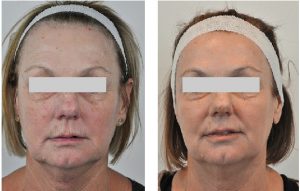
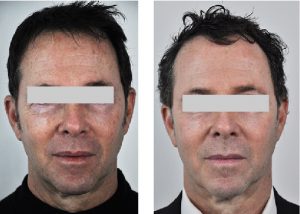
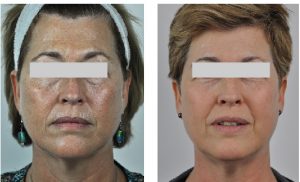
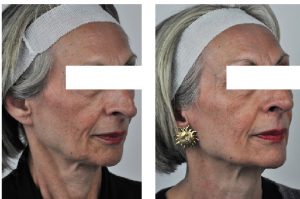 A�
A�